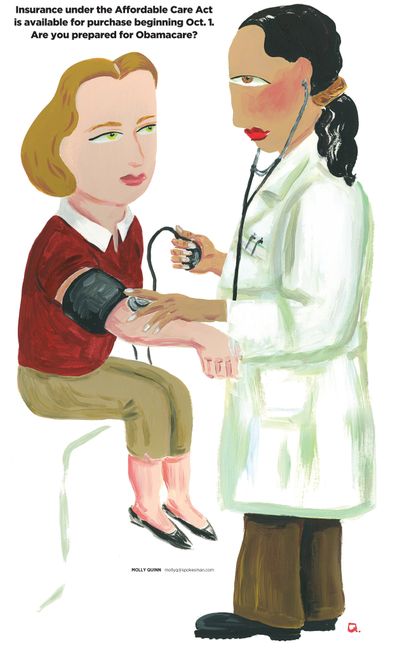Affordable Care Act: What it means for you

How will the Affordable Care Act affect you? Most Americans will be affected in some way, but the answer depends on where they live and how they get – or don’t get – health coverage now.
The state in which people live is a factor because some states, such as Washington, have worked for years to implement the law and have taken advantage of federal funding to expand Medicaid. But other states, such as Idaho, fought the law, delayed their implementation work and refused to accept federal Medicaid expansion dollars. In states such as Florida and Georgia, elected officials not only have fought the federal law, they’ve said they intend to make it difficult for their uninsured residents to sign up for health care coverage.
Here’s a summary of the federal law’s effects:
For Medicare recipients
• The law phases out the so-called “donut hole” by increasing Medicare’s Part D coverage of prescription drugs.
• It extends the viability of Medicare’s trust fund by at least a decade, to 2026. This was accomplished partly by requirements for less waste in Medicare Advantage plans, and partly by increasing the Medicare payroll tax rate from 1.45 percent to 2.5 percent – but only on individuals making more than $200,000/year or couples making more than $250,000.
• Medicare now must cover preventive services such as yearly wellness visits, mammograms and colonoscopies, without any patient fees such as co-pays.
For Medicaid recipients
In the past, Medicaid varied greatly from state to state and often provided little assistance to adults. Mostly, it covered children.
• The Affordable Care Act provided federal funds to expand Medicaid, making it a comprehensive health insurance plan for all ages up to 138 percent of the federal poverty level. Washington and 24 other states, as well as the District of Columbia, accepted funds to expand Medicaid. Idaho is among the 25 states that did not expand Medicaid.
• Medicaid applications must be accepted and processed online, at insurance-buying websites, one for each state. To answer questions and assist applicants without computer access, each state must provide a toll-free call center, as well as trained and certified providers of in-person assistance.
• In states that chose not to expand Medicaid, the lowest-income adults, those below the poverty line, will have no way to get affordable health coverage. Federal insurance-buying subsidies are available only to those with income above the poverty line, because the federal law assumed all states would expand Medicaid.
People insured through their employer
• Young people can remain on their parents’ insurance through age 26.
• Lifetime caps on coverage are prohibited. In most cases, annual caps on coverage also are prohibited.
• Insurance plans are prohibited from canceling coverage if people make an honest, accidental mistake in their application.
• Large-group insurance plans must pay consumers a rebate if they spend more than 15 cents of each premium dollar on overhead costs.
• Group health plans cannot refuse to cover a pre-existing condition.
• If the employee-only premium for employer-provided health insurance costs more than 9.5 percent of household income, the employee can seek a federally subsidized policy on the government’s insurance-buying website. Because this provision only considers the premium for the employee, it has been criticized as the “ family glitch”: if an employer provides little coverage for an employee’s dependents, the employee’s high cost for dependent coverage does not entitle the employee to get a federal subsidy for family coverage on the government’s website.
People with individual coverage, or no coverage
• For each state, the government must operate a secure online marketplace where competing, private health insurance companies will sell coverage. If states decline to create a marketplace, the federal government will do it for them, at www.healthcare.gov. To support these online marketplaces, for each state there must be a toll-free call-in center as well as trained, certified providers of in-person assistance.
• Sales begin Oct. 1 at the online marketplaces, for coverage that will take effect Jan. 1.
• Federal tax credits will reduce the premiums for insurance sold on these online marketplaces, for households with income below 400 percent of the poverty level ($94,200/year for a family of four). These new tax credits are similar in concept to the tax break received by those who get their coverage as a tax-free fringe benefit of employment.
• Insurance companies are prohibited from denying coverage or charging more because an applicant is sick. Issuance of a policy is required. Rates are based on the cost for a statewide pool of customers, not on the health status of each individual.
• All policies must provide 100 percent coverage of preventive care such as wellness checks, mammograms and colonoscopies, with no co-pays.
• All policies must cover 10 essential benefits: ambulatory services, emergency services, hospitalization, maternity and newborn care, mental health, prescription drugs, rehabilitation, laboratory services, prevention and wellness, and pediatric services including dental and vision care.
• Consumers can choose between four standard levels of coverage, plus a high-deductible plan for those under age 30.
• The online marketplaces must include a rating system to help consumers compare the quality and coverage of plans, on an “apples-to-apples” basis.